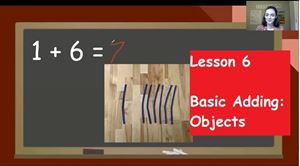
Lesson 6 - Basic Adding: Object, focuses on how to use objects to recreate and solve a basic addition equation within 10. It introduces important addition terminology such as, addend, sum, part, and whole. The lesson has one exercise document for students to complete and 1 exercise review video for students to watch to review the answers and ways to solve the tasks on the exercise.
The lesson video is 13:38.
The exercise has 8 problems and should take about 10 minutes to complete.
This lesson most closely aligns with Kindergarten math standard, CCSS.MATH.CONTENT.K.OA.A.1 “Represent addition and subtraction with objects, fingers, mental images, drawings, sounds (e.g., claps), acting out situations, verbal explanations, expressions, or equations.”
It also aligns with a First Grade math standard, CCSS.MATH.CONTENT.1.OA.C.6 “Add and subtract within 20, demonstrating fluency for addition and subtraction within 10. Use strategies such as counting on; making ten; decomposing a number leading to a ten; using the relationship between addition and subtraction ; and creating equivalent but easier or known sums.”
This video walks students through the answers to the exercise for lesson 6. The video highlights steps and strategies that students should have used when completing the exercise.
The length of the video is 4:41.
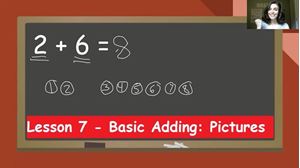
Lesson 7- Basic Adding: Picture, focuses on how to draw quick pictures to show and solve a basic addition equation within 10. It reviews important addition terminology such as, addend, sum, part, and whole. The lesson has one exercise document for students to complete and 1 exercise review video for students to watch to review the answers and ways to solve the tasks on the exercise.
The lesson video is 10:10.
The exercise has 8 problems and should take about 10 minutes to complete.
This lesson most closely aligns with Kindergarten math standard, CCSS.MATH.CONTENT.K.OA.A.1 “Represent addition and subtraction with objects, fingers, mental images, drawings, sounds (e.g., claps), acting out situations, verbal explanations, expressions, or equations.”
It also aligns with a First Grade math standard, CCSS.MATH.CONTENT.1.OA.C.6 “Add and subtract within 20, demonstrating fluency for addition and subtraction within 10. Use strategies such as counting on; making ten; decomposing a number leading to a ten; using the relationship between addition and subtraction ; and creating equivalent but easier or known sums.”
This video walks students through the answers to the exercise for lesson 7. The video highlights steps and strategies that students should have used when completing the exercise.
The length of the video is 7:36.
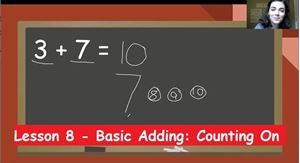
Lesson 8- Basic Adding: Counting On, focuses on how to count on with a quick picture to solve a basic addition equation within 10. It reviews important addition terminology such as, addend, sum, part, and whole. The lesson has one exercise document for students to complete and 1 exercise review video for students to watch to review the answers and ways to solve the tasks on the exercise.
The lesson video is 10:35.
The exercise has 8 problems on it and should take about 12 minutes to complete.
This lesson most closely aligns with Kindergarten math standard, CCSS.MATH.CONTENT.K.OA.A.1 “Represent addition and subtraction with objects, fingers, mental images, drawings, sounds (e.g., claps), acting out situations, verbal explanations, expressions, or equations.”
It also aligns with a First Grade math standard, CCSS.MATH.CONTENT.1.OA.C.5 “Relate counting to addition and subtraction.”
This video walks students through the answers to the exercise for lesson 8. The video highlights steps and strategies that students should have used when completing the exercise.
The length of the video is 7:59.
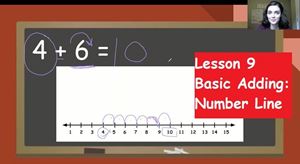
Lesson 9 - Basic Adding: Number Line, focuses on how to count on with a number line to solve a basic addition equation within 10. It reviews important addition terminology such as, addend, sum, part, and whole. The lesson has one exercise document for students to complete and 1 exercise review video for students to watch to review the answers and ways to solve the tasks on the exercise.
Please print a blank set of number lines to 15 prior to your student watching the lesson video so they can have number lines to do work on during the video lesson.
The lesson video is 14:41.
The exercise has 8 problems and should take about 12 minutes to complete.
This lesson most closely aligns with Kindergarten math standard, CCSS.MATH.CONTENT.K.OA.A.1 “Represent addition and subtraction with objects, fingers, mental images, drawings, sounds (e.g., claps), acting out situations, verbal explanations, expressions, or equations.”
It also aligns with a First Grade math standard, CCSS.MATH.CONTENT.1.OA.C.5 “Relate counting to addition and subtraction.”
This video walks students through the answers to the exercise for lesson 9. The video highlights steps and strategies that students should have used when completing the exercise.
The length of the video is 6:22.
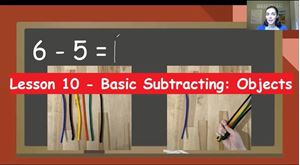
Lesson 10 - Basic Subtracting: Objects, focuses on how to use objects to recreate and solve a basic subtraction equation within 10. It introduces important subtraction terminology such as, minuend, subtrahend, difference, part, and whole. The lesson has one exercise document for students to complete and 1 exercise review video for students to watch to review the answers and ways to solve the tasks on the exercise.
The lesson video is 12:24.
The exercise has 8 problems and should take about 10 minutes to complete.
This lesson most closely aligns with Kindergarten math standard, CCSS.MATH.CONTENT.K.OA.A.1 “Represent addition and subtraction with objects, fingers, mental images, drawings, sounds (e.g., claps), acting out situations, verbal explanations, expressions, or equations.”
It also aligns with a First Grade math standard, CCSS.MATH.CONTENT.1.OA.C.6 “Add and subtract within 20, demonstrating fluency for addition and subtraction within 10. Use strategies such as counting on; making ten; decomposing a number leading to a ten; using the relationship between addition and subtraction; and creating equivalent but easier or known sums.”
This video walks students through the answers to the exercise for lesson 10. The video highlights steps and strategies that students should have used when completing the exercise.
The length of the video is 6:02.
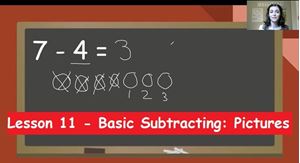
Lesson 11 - Basic Subtracting: Pictures, focuses on how to draw quick pictures to represent and solve a basic subtraction equation within 10. It reviews important subtraction terminology such as, minuend, subtrahend, difference, part, and whole. The lesson has one exercise document for students to complete and 1 exercise review video for students to watch to review the answers and ways to solve the tasks on the exercise.
The lesson video is 9:52.
The exercise has 8 problems and should take about 10 minutes to complete.
This lesson most closely aligns with Kindergarten math standard, CCSS.MATH.CONTENT.K.OA.A.1 “Represent addition and subtraction with objects, fingers, mental images, drawings, sounds (e.g., claps), acting out situations, verbal explanations, expressions, or equations.”
It also aligns with a First Grade math standard, CCSS.MATH.CONTENT.1.OA.C.6 “Add and subtract within 20, demonstrating fluency for addition and subtraction within 10. Use strategies such as counting on; making ten; decomposing a number leading to a ten; using the relationship between addition and subtraction; and creating equivalent but easier or known sums.”
This video walks students through the answers to the exercise for lesson 11. The video highlights steps and strategies that students should have used when completing the exercise.
The length of the video is 5:16.
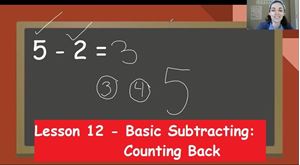
Lesson 12 - Basic Subtracting: Counting Back, focuses on how to draw a quick picture to count backward and solve a basic subtraction equation within 10. It reviews important subtraction terminology such as, minuend, subtrahend, difference, part, and whole. The lesson has one exercise document for students to complete and 1 exercise review video for students to watch to review the answers and ways to solve the tasks on the exercise.
The lesson video is 10:10.
The exercise has 8 problems and should take about 12 minutes to complete.
This lesson most closely aligns with Kindergarten math standard, CCSS.MATH.CONTENT.K.OA.A.1 “Represent addition and subtraction with objects, fingers, mental images, drawings, sounds (e.g., claps), acting out situations, verbal explanations, expressions, or equations.”
CCSS.MATH.CONTENT.1.OA.C.5 “Relate counting to addition and subtraction.”
This video walks students through the answers to the exercise for lesson 12. The video highlights steps and strategies that students should have used when completing the exercise.
The length of the video is 6:45.
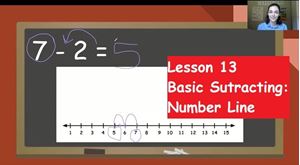
Lesson 13 - Basic Subtracting: Number Line, focuses on how to use a number line to count backward and solve a basic subtraction equation within 10. It reviews important subtraction terminology such as, minuend, subtrahend, difference, part, and whole. The lesson has one exercise document for students to complete and 1 exercise review video for students to watch to review the answers and ways to solve the tasks on the exercise.
Please print a blank set of number lines to 15 prior to your student watching the lesson video so they can have number lines to do work on during the video lesson.
The lesson video is 9:35.
The exercise has 8 problems and should take about 12 minutes to complete.
This lesson most closely aligns with Kindergarten math standard, CCSS.MATH.CONTENT.K.OA.A.1 “Represent addition and subtraction with objects, fingers, mental images, drawings, sounds (e.g., claps), acting out situations, verbal explanations, expressions, or equations.”
CCSS.MATH.CONTENT.1.OA.C.5 “Relate counting to addition and subtraction.”
This video walks students through the answers to the exercise for lesson 13. The video highlights steps and strategies that students should have used when completing the exercise.
The length of the video is 5:57.
After watching the video please complete the Addition and Subtraction Quiz. This quiz covers basic addition and subtraction that has been taught so far.
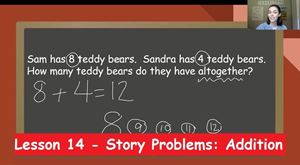
Lesson 14 - Story Problems: Addition, focuses on how to create an addition equation base on a story problem and how to solve for the answer. It reviews important addition terminology such as, addend, sum, part, and whole. The lesson has one exercise document for students to complete and 1 exercise review video for students to watch to review the answers and ways to solve the tasks on the exercise.
The lesson video is 14:25.
The exercise has 4 problems and should take about 12 minutes to complete.
This lesson most closely aligns with First Grade math standard, CCSS.MATH.CONTENT.1.OA.A.1 “Use addition and subtraction within 20 to solve word problems involving situations of adding to, taking from, putting together, taking apart, and comparing, with unknowns in all positions, e.g., by using objects, drawings, and equations with a symbol for the unknown number to represent the problem.”
This lesson is also related to the following standards.
CCSS.MATH.CONTENT.K.OA.A.2 “Solve addition and subtraction word problems, and add and subtract within 10, e.g., by using objects or drawings to represent the problem.”
This video walks students through the answers to the exercise for lesson 14. The video highlights steps and strategies that students should have used when completing the exercise.
The length of the video is 6:05.
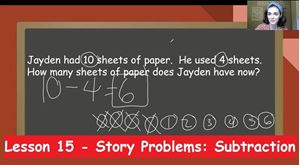
Lesson 15 - Story Problems: Subtraction, focuses on how to create a subtraction equation based on a story problem and how to solve for the answer. It reviews important subtraction terminology such as, minuend, subtrahend, difference, part, and whole. The lesson has one exercise document for students to complete and 1 exercise review video for students to watch to review the answers and ways to solve the tasks on the exercise.
The lesson video is 11:33.
The exercise contains 4 problems and should take about 12 minutes to complete.
This lesson most closely aligns with First Grade math standard, CCSS.MATH.CONTENT.1.OA.A.1 “Use addition and subtraction within 20 to solve word problems involving situations of adding to, taking from, putting together, taking apart, and comparing, with unknowns in all positions, e.g., by using objects, drawings, and equations with a symbol for the unknown number to represent the problem.”
This lesson is also related to the following standards.
CCSS.MATH.CONTENT.K.OA.A.2 “Solve addition and subtraction word problems, and add and subtract within 10, e.g., by using objects or drawings to represent the problem.”
This video walks students through the answers to the exercise for lesson 15. The video highlights steps and strategies that students should have used when completing the exercise.
The length of the video is 6:24.
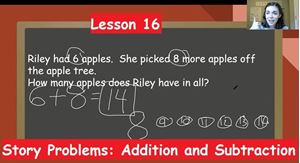
Lesson 16 - Story Problems: Addition and Subtraction, focuses on how to determine the operation when creating an equation based on a story problem and how to solve for the answer. This lesson introduces the term operation and reviews important terminology such as, addend, sum, minuend, subtrahend, difference, part, and whole. The lesson has one exercise document for students to complete and 1 exercise review video for students to watch to review the answers and ways to solve the tasks on the exercise.
The lesson video is 13:44.
The exercise contains 4 questions and should take about 12 minutes.
This lesson most closely aligns with First Grade math standard, CCSS.MATH.CONTENT.1.OA.A.1 “Use addition and subtraction within 20 to solve word problems involving situations of adding to, taking from, putting together, taking apart, and comparing, with unknowns in all positions, e.g., by using objects, drawings, and equations with a symbol for the unknown number to represent the problem.”
This lesson is also related to the following standards.
CCSS.MATH.CONTENT.K.OA.A.2 “Solve addition and subtraction word problems, and add and subtract within 10, e.g., by using objects or drawings to represent the problem.”
This video walks students through the answers to the exercise for lesson 16. The video highlights steps and strategies that students should have used when completing the exercise.
The length of the video is 6:36.
After the video, please complete the Story Problems Quiz. This quiz covers basic addition and subtraction story problems.
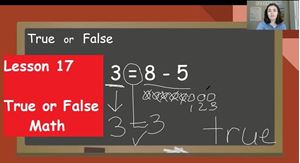
Lesson 17 - True or False Math, focuses on how to determine if equations written are true or false. This lesson reviews the meaning of the equal sign in an equation. This lesson introduces the terms true and false. To complete this activity, students must be able to accurately solve basic addition and subtraction problems independently. The lesson has one exercise document for students to complete and 1 exercise review video for students to watch to review the answers and ways to solve the tasks on the exercise.
The lesson video is 19:39.
The exercise contains 8 problems and should take about 20 minutes.
This lesson most closely aligns with First Grade math standard, CCSS.MATH.CONTENT.1.OA.D.7 “Understand the meaning of the equal sign, and determine if equations involving addition and subtraction are true or false.”
This video walks students through the answers to the exercise for lesson 17. The video highlights steps and strategies that students should have used when completing the exercise.
The length of the video is 12:12
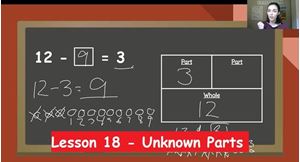
Lesson 18 - Unknown Parts, focuses on how to solve unknown parts problems. This lesson reviews the parts and the whole in addition and subtraction equations. This lesson teaches how to turn an unknown part equation into a solvable subtraction equation. To complete this activity, students must be able to accurately solve basic subtraction problems independently. The lesson has two exercise documents for students to complete and 2 exercise review videos for students to watch to review the answers and ways to solve the tasks on the exercise.
The lesson video is 22:13.
Exercise 1 contains 6 problems and should take about 15 minutes.
Exercise 2 contains 6 problems and should take about 15 minutes.
Please make sure that the student watches the matching exercise review video shortly after finishing the exercise.
This lesson most closely aligns with First Grade math standard, CCSS.MATH.CONTENT.1.OA.D.8 “Determine the unknown whole number in an addition or subtraction equation relating three whole numbers.”
This video walks students through the answers to the exercise 1 for lesson 18. The video highlights steps and strategies that students should have used when completing the exercise.
The length of the video is 10:22.
This video walks students through the answers to the exercise 2 for lesson 18. The video highlights steps and strategies that students should have used when completing the exercise.
The length of the video is 8:55.
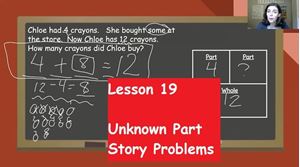
Lesson 19 - Unknown Part Story Problems, focuses on how to turn story problems into unknown parts equations then solve. This lesson reviews the parts and the whole in addition and subtraction equations. This lesson reviews how to turn an unknown part equation into a solvable subtraction equation. To complete this activity, students must be able to accurately determine the operation in a story problem. The lesson has two exercise documents for students to complete and 2 exercise review videos for students to watch to review the answers and ways to solve the tasks on the exercise.
The lesson video is 18:57.
Exercise 1 contains 4 problems and should take about 15 minutes.
Exercise 2 contains 4 problems and should take about 15 minutes.
Please make sure that the student watches the matching exercise review video shortly after finishing the exercise and before moving on.
This lesson most closely aligns with First Grade math standards, CCSS.MATH.CONTENT.1.OA.D.8 “Determine the unknown whole number in an addition or subtraction equation relating three whole numbers.”
and
CCSS.MATH.CONTENT.1.OA.A.1 “Use addition and subtraction within 20 to solve word problems involving situations of adding to, taking from, putting together, taking apart, and comparing, with unknowns in all positions, e.g., by using objects, drawings, and equations with a symbol for the unknown number to represent the problem.”
This video walks students through the answers to the exercise 1 for lesson 19. The video highlights steps and strategies that students should have used when completing the exercise.
The length of the video is 10:33.
This video walks students through the answers to the exercise 2 for lesson 19. The video highlights steps and strategies that students should have used when completing the exercise.
The length of the video is 11:13.
After the video, please complete the True or False and Unknown Parts Quiz.
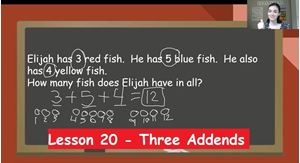
Lesson 20 - Three Addends, focuses on how to turn story problems into addition equations then solve. This lesson reviews addition terminology addend and sum. This lesson introduces putting 3 addends together. To complete this activity, students must be able to accurately solve basic addition problems. The lesson has one exercise document for students to complete and 1 exercise review video for students to watch to review the answers and ways to solve the tasks on the exercise.
The lesson video is 18:51.
The exercise contains 4 problems and should take about 10 minutes.
Please make sure that the student watches the matching exercise review video shortly after finishing the exercise and before moving on.
This lesson most closely aligns with First Grade math standard, CCSS.MATH.CONTENT.1.OA.A.2 “Solve word problems that call for addition of three whole numbers whose sum is less than or equal to 20, e.g., by using objects, drawings, and equations with a symbol for the unknown number to represent the problem.”
This video walks students through the answers to the exercise for lesson 20. The video highlights steps and strategies that students should have used when completing the exercise.
The length of the video is 5:51.
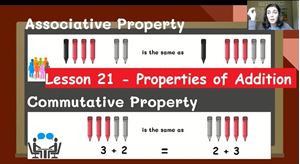
Lesson 21 - Properties of Addition, focuses on the commutative and associative properties of addition. This lesson introduces addition terminology commutative property and associative. This lesson is focused on finding different equations that will have the same sum due to the properties. The lesson has one exercise document for students to complete and 1 exercise review video for students to watch to review the answers and ways to solve the tasks on the exercise.
The lesson video is 21:35.
The exercise contains 2 matching sets and should take about 10 minutes.
Please make sure that the student watches the matching exercise review video shortly after finishing the exercise and before moving on.
This lesson most closely aligns with First Grade math standard, CCSS.MATH.CONTENT.1.OA.B.3 “Apply properties of operations as strategies to add and subtract. Examples: If 8 + 3 = 11 is known, then 3 + 8 = 11 is also known. (Commutative property of addition.) To add 2 + 6 + 4, the second two numbers can be added to make a ten, so 2 + 6 + 4 = 2 + 10 = 12. (Associative property of addition.)”
This video walks students through the answers to the exercise for lesson 21. The video highlights steps and strategies that students should have used when completing the exercise.
The length of the video is 7:10.
After watching the video, please complete the Counting and Operations Test. This test covers all math topics we have learned so far.
